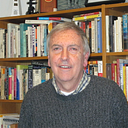Member-only story
The One Minute Geographer: Megalopoli and Megaregions
We’ve been talking about Connecticut, and even though this post is not about that specific state, Connecticut is a good illustration of what this post is about — Megalopolis, the giant super-strip city extending down the east coast from Boston to Washington. New York and its urban and suburban spillover into New Jersey, Connecticut and even East Stroudsburg PA makes up the largest city of this super strip which includes Philadelphia and Baltimore and many other cities along the way like Hartford and Providence. The suburbs of these cities spill over and overlap into each other so that when viewed from space, it seems like one giant strip of lights.
This idea of calling this giant strip-city “Megalopolis,” is a concept introduced in the 1950’s by a visiting French geographer, Jean Gottmann. And Megalopolis really begins in the northern fringe of Boston’s suburbs in southern New Hampshire and extends all the way down to the farthest western and southern suburbs of Washington in Northern Virginia. Some argue that it’s such a short hop from Washington to Richmond and then to the Newport News-Virginia beach area of Virginia, that the strip extends all the way down the Chesapeake Bay. But you can look at the map of population in urbanized areas below and decide for yourself if you think Richmond and the Norfolk metro should be included.
